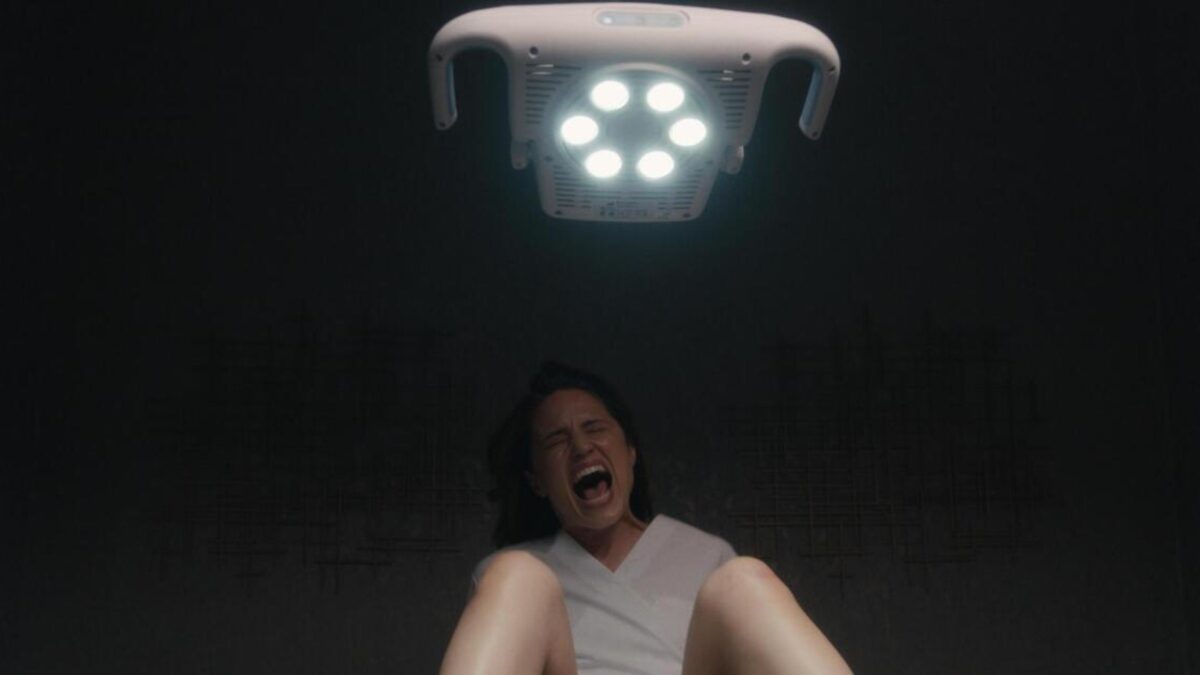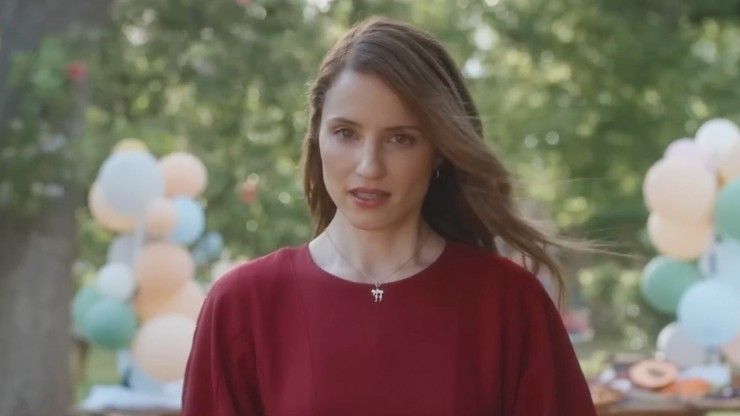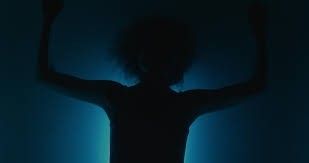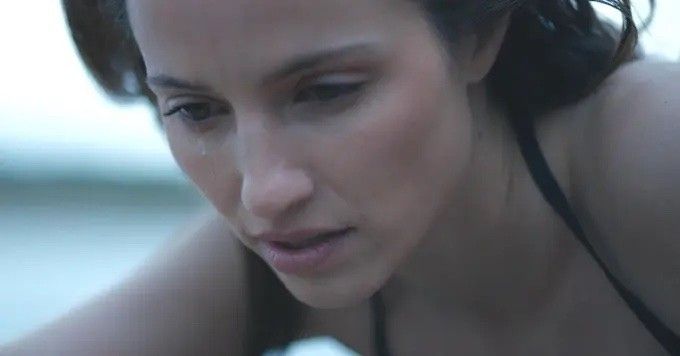
Clock editor Alexandra Amick sits down with No Film School to break down the horror of her latest project.
This year has been a great year for horror movies. From classic slasher movies like M3GAN and Scream 6 to the more avant-garde horror films like Beau is Afraid and the gruesome body horror of Evil Dead Rise, I can confidently say that horror is alive.
Writer/director Alexis Jacknow’s female body horror Clock arrives at the perfect time. The curl-your-toes horror is a grotesque and psychological trip as the story follows Ella (Dianna Agron) trying an experimental treatment to “fix” her biological clock. Outside of the gaslighting and typical horrors that aging, married women face in their day-to-day lives, Clock is relentless in its torture of Ella’s and the viewer’s subjective realities.
To create this restless energy in Clock, editor Alexandra Amick sat down over Zoom to talk with No Film School about working within the horror genre, women’s body horror, the real-life elements of horror involved, and creating a sensory experience through the edit.
Video is no longer available: youtu.be/5h3WqGDpeYs
Editor’s Note: This interview has been edited for length and clarity.
No Film School: Congratulations on Clock being out on Hulu in the US for everybody to watch. How did you join this project and what made you excited to be a part of this story?
Alexandra Amick: I was reached out to by one of the producers, Leal, I think he got my name from a friend of a friend of a friend, really. I was sent the script and I read the script and the first thing I thought was, “Wow, this is weird.” But we are not pulling punches with our metaphorical references here. We are sucking frozen eggs. We’re spooning caviar. We’re in a sensory deprivation pod that looks like a giant egg.
What I really, really liked about it and what made me want to meet Alexis, the writer/director, and really see if this was a project for me, was how the issue of having babies was tackled I think. I don’t think the script or the film itself, it never says, “Don’t have babies.” It just says that this woman should not have babies because she didn’t want them. If you don’t want babies, don’t let other people pressure you into that and you should live your life the way that you want to. Which was important to me because I wasn’t pregnant at the time but was planning on it. I definitely didn’t want to work on a project that I felt was against what I wanted to do with my life.
I had been on both sides of it. For a long time, I wasn’t sure if I wanted to have kids. Then, when I decided to, it felt like a movie that could speak to both.
NFS: I like that the film never made anyone feel bad for the choices that they wanted to go about. But because it’s being told through a subjective lens, it’s like everyone’s peer pressuring and gaslighting Ella.
Amick: Yeah, I know. Which is just so wrong. So, so wrong. But I think it’s the way things are in real life, which makes it terrifying already. You don’t need the jumpscares for it to be a scary story of what women face every day.
NFS: This is a film that’s deeply embedded in the horror genre. It’s body horror in a way. As an editor, what draws you to this genre and what are those fun pockets to live in when you’re cutting the film?
Amick: I think that horror is such a great genre because it is set up to subvert expectations. That is its purpose. To earn a jump scare, you have to subvert what the audience is expecting. The audience thinks, “Oh, is it going to come now? Is it going to come now? Is it going to come now?” No, it’s going to come now. That’s how you get them to be scared. Also, just how a plot unfolds in horror, should be subverting your expectations.
And it’s because of that, you can discuss more taboo subjects, subjects that are hidden away, so to speak. Women’s issues are those things. They shouldn’t be. They shouldn’t be taboo. They shouldn’t be uncomfortable. They shouldn’t be scary. But they are. They aren’t talked about. Birth is a scary thing and a very physical body horror-type thing. And so it definitely… We were able to bring a real-life sense of horror to it. Then beyond that, plus it up with things that are not so real to life, like hallucinations and stuff like that.
NFS: The way you also cut scenes and play with silence throughout the film is really interesting, too. I think the one scene in particular that I think about is right after she discovers a spider and she’s in the therapy session and it’s a very intense conversation that cuts to a wide, that’s just goes well, great session today. How are you finding these dynamic balances within these conversations to keep it very engaging to watch?
Amick: It’s very difficult from an editorial point of view when you have long stretches of dialogue, no matter how engaging that dialogue is. Reading it is one thing but watching it is another. And so I worked really, obviously very closely with Alexis, and we really had to hone when we showed… Which character, when it was close when it was far away when we pulled back when, yeah, we just sat in that moment.
I like that you pointed that out because that was very important to us to pull back and just sit there and then be like, welp move on. Which I think is speaking to Melora’s character, Dr. Simmons, if we’re dealing with something extremely personal and dark, but it’s just kind of every day for her. You’re totally… “Oh, you don’t want babies? You’re broken. I’ll fix you.” Which is so gross and she’s so flippant about it in that way. And so I think we tried to emulate that kind of feeling of what it would be like sitting, from both sides of the conversation, in something like that.

NFS: Then you also have the ticking clock motif throughout the entire film, be that in an actual clock or just the repetition of sound. Were those baked into the script already or was that something that you implemented during the editing process?
Amick: Both, I think. Obviously, the clock motif was present in the script. She hallucinates hearing clocks. She walks by the grandfather clock and it’s a constant reminder of her own ticking clock. Then, the grandfather clock especially is an heirloom piece from people who sacrificed a lot so that she could be here. So it’s a representation of what she would be giving up if she doesn’t have anyone to pass along the heritage or the clock.
I think that we kind of found it in the edit repetition of sound. Hearing Dr. Simmons’s voiceover that repeats from the tank scene, which wasn’t necessarily scripted. Then, we worked really closely with our amazing sound design team over at the Sound Department, Juan Campos and Zach Goheen. They were so great and our composer, Steven Lukach, was amazing in that too. I think they really understood that and brought another level to that process as well.
It was there in the script, we added more to it in the editorial, and then sound took over and just really made it cross the finish line in that sense. And so you really felt that sense of rhythm throughout the whole thing?
NFS: It was definitely something I noticed right at the beginning that it was going to be one of those motifs we followed through. Another thing that I didn’t realize was happening throughout the film until the very end was the desaturation of color throughout. Was that also part of the script or was it something that you guys discussed in the process?
Amick: It was a part of the script. Yes. Alexis very specifically noted in the script that once the implant goes in that very slowly from here on out, the color will desaturate slowly and you won’t be able to notice it and I think having a character as an interior designer known as “The Color Authority” and having that slowly be taken away from her was a really great metaphor for what she’s giving up. She gives up her career. She gives up a big chance of a big gig, and it kind of represents what she was scared of if she were to have a kid, which is sacrificing things that she loves.
So yeah, I mean, it was always planned. It was a very effective tool because yeah, you don’t notice it, you just feel it, until it all comes back. And also when the implant goes in, there’s a switch from locked off, like dolly and on a tripod shots, to only handheld. And so you just start to feel more unmoored and the camera gets… The camera work gets more and more shaky as she gets more and more unhinged in her mind. And so I think it really works really, really well.
NFS: As the editor, how do you slowly make that desaturation more and more prevalent without the audience really noticing it?
Amick: I would say that was more the colorist. I mean, it was just a very slow fade. In editorial, it was just setting very technically a layer above all of the footage and setting it from 100% saturation. While I was editing, I don’t know what it ended up being in the official color correction, but down to right before she rips the implant out to 30% saturation. And so it was just literally just a line slowly descending. And so from one shot to the next, it might be half a percent desaturation. And so by the time you get there, you don’t realize you’ve started until it all comes back.
NFS: It was such a fun moment in the story. I felt like a bad viewer for not noticing it.
Amick: No. Everybody pointed that out and said, “I didn’t notice until it all came back.” It just felt depressing. It felt washed out, but you didn’t realize that we had literally taken the color out.” But also that was in the production design as well, especially in the cafeteria. She was wearing a different color nightgown, and then they changed her… The production design on the walls, there are origami bird sculptures on the walls. They changed those out and then changed them back to pink versus white. The other women at the clinic, their outfits were white, and then when she pulled it out, they change to pink. So it was very intentional so that even if it was more than just coloring and desaturation, it was all around practically as well.

NFS: In terms of advancing the film from the earliest assembly to the final cut, what are your goals as an editor?
Amick: I guess that depends on where the assembly lands. Depending on how much time I have to work on an assembly, which is normally not much. My goal within assembly is normally to present everything that has been shot to a director and then take some stylistic swings, definitely. Then, maybe make some bigger decisions, like maybe cutting out, maybe not an entire scene, but half a scene. If I feel like I don’t like it for whatever reason or I feel it’s repetitive or for whatever reason, I might do something like that.
But really my goal is for a director to watch an assembly and think, “Okay, this is a real movie.” Because anytime, whether it’s a first-time director or a seasoned director, the first time they watch an assembly is like, “Did I make a movie? Did I do it?”
You come off the high of set and then you remember all the things that you sacrificed, the problems that you had. It’s like, “Oh my God, did we get that close up? Did she do the performance that I wanted?” So, hopefully, when they watch an assembly, they think, “Okay, I did get it.” Now, most of the time they tend to freak out a little bit because it is not exactly what they thought it would be or the choices I made aren’t what they intended originally.
Then from there, they watch it with me. I watch their reactions and see what scenes they seem to be very upset by, scenes that they maybe really like. And then I talk to them afterward about what I feel like how the film can progress and how we can move forward. In this case, I think it needed a more distinct style moving forward and really just going for it in terms of the style of the film matching the decline of Ella’s mental health, and then really working on Ella herself and making sure that we were always in her headspace.
This is always through the lens of Ella and Alexis agreed and that’s what we work towards. I think grounding every version of the cut, every scene moving forward in your main character or in whichever character it’s supposed to be grounded in. That’s how I look at moving it all the way forward. Then, obviously pacing and then the style that we talked about that falls into place around that. But it just evolves and you get notes from the outside and you try and incorporate those into what you’re working towards. And then you get your final product and, hopefully, it’s what you discussed that you wanted at the beginning.
NFS: There’s that saying where it’s the editing process is the third writer of the movie. You have the actual writer, the director, and then you have the editing. I can understand how sometimes when you look at it for the first time it might not be exactly what you imagined, but it’s those rewrites and all those things or the re-edits that make it a full-fledged movie.
Amick: Definitely. I mean, Alexis was really bold and fearless about throwing out things from the script and redoing things in a way that she hadn’t already thought about that we found along the way. We reordered scenes. We withheld information that originally we weren’t planning on withholding. It definitely is another rewrite of the film.

NFS: What was the editing software that you used for this film, and what were the advantages of using that one?
Amick: I used Premiere Pro. I think I’ve been using it for a really long time, I’m very familiar with it. It’s a lightweight software, and I think really it’s in program VFX and graphics that you can use right within the program really help. I don’t have to send it to another program to do anything. I can do the color correction and make that desaturation very easily. I can do a split screen and stitch two actors’ different performances together very easily. I can cut out a character and put her on a different background if I really need to, all within the program. I think that makes it work and I work faster.
NFS: It’s crazy to see the evolution of Premiere Pro, especially in the industry with it winning its first Oscar actually with Everything, Everywhere. It’s becoming the new industry standard so it’s really fun to see.
Amick: Definitely. I think editing software doesn’t have to be expensive anymore. It doesn’t have to be cost-prohibitive. And then also with, I think Adobe’s move towards collaborative editing, which I think that Avid had kind of the market on for a long time of multiple people working on multiple computers on the same project, but now they’ve moved into that, and made it so that we can work that way as well. I’d come a long, long way.
NFS: What was your favorite scene from Clock to edit and why?
Amick: I guess it’s a little bit of a spoiler, but my favorite scene is in the kitchen with Ella and her husband Aidan after she’s just destroyed the grandfather clock. He comes home and she finally crosses that threshold of the treatment and says, “I want a baby.” Then, bad things happen from there.
But it was a challenging scene to edit because there are so many pieces of it. It’s over here on this side of the kitchen, and it’s this section of coming in and seeing her hands. And then it’s over by the sink, and it’s a slow seduction of washing hands and making washing hands seem sexy. And then it’s, “Oh my God, she’s fully crazed and she wants a baby.”
Alexis and I would constantly… We loved Dianna Agron’s performance in that scene when she’s like, “Give me a baby.” And we’re like, “No, do not give that woman a baby. Don’t do it.” Yeah, I mean, both of their performances throughout that scene are incredible, but it has that moment and then they go for it, and they try to have a baby and or make a baby, and then that does not go well. Then things are revealed, and it was just so fun. All the different pieces to put it together, and then their performances made it really great to work with all of that footage.

NFS: Do you have any advice for any editors who are looking to work in genre pieces like horror?
Amick: I would say do your research.
Watch horror films, but also watch non-horror films, because like I said, horror is about subverting expectations. I think that what makes the horror films of today so good is that they are genre-bending. They’re merging multiple genres within one. Knowing and watching how to pull off a jump scare is very important.
But also making sure that you’re watching character pieces and understanding that just because it’s scary doesn’t mean it can’t be poignant, doesn’t mean it can’t be timely, doesn’t mean it can’t have a message and so you need to make sure that you’re doing your research and understand how to make a good movie, whether it’s horror or not.














